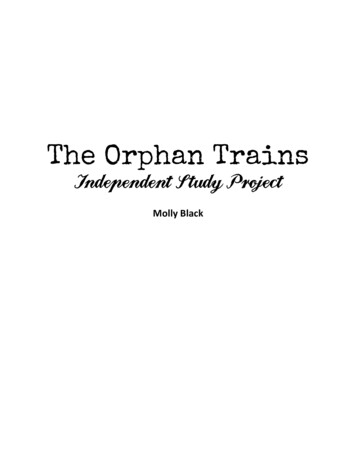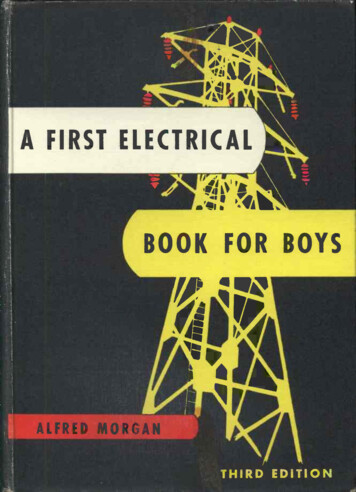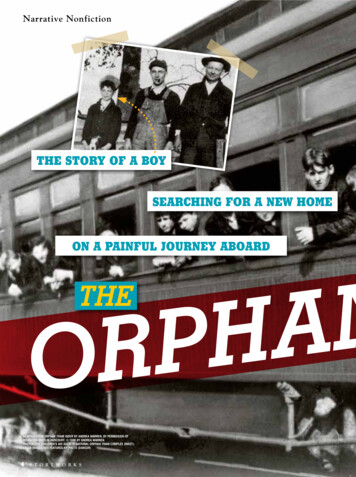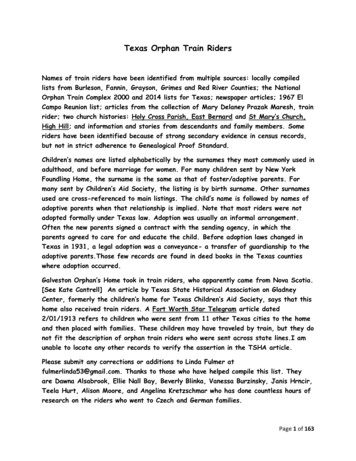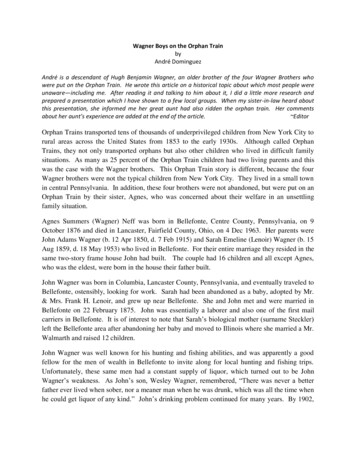
Transcription
Wagner Boys on the Orphan TrainbyAndré DominguezAndré is a descendant of Hugh Benjamin Wagner, an older brother of the four Wagner Brothers whowere put on the Orphan Train. He wrote this article on a historical topic about which most people wereunaware—including me. After reading it and talking to him about it, I did a little more research andprepared a presentation which I have shown to a few local groups. When my sister-in-law heard aboutthis presentation, she informed me her great aunt had also ridden the orphan train. Her commentsabout her aunt’s experience are added at the end of the article. EditorOrphan Trains transported tens of thousands of underprivileged children from New York City torural areas across the United States from 1853 to the early 1930s. Although called OrphanTrains, they not only transported orphans but also other children who lived in difficult familysituations. As many as 25 percent of the Orphan Train children had two living parents and thiswas the case with the Wagner brothers. This Orphan Train story is different, because the fourWagner brothers were not the typical children from New York City. They lived in a small townin central Pennsylvania. In addition, these four brothers were not abandoned, but were put on anOrphan Train by their sister, Agnes, who was concerned about their welfare in an unsettlingfamily situation.Agnes Summers (Wagner) Neff was born in Bellefonte, Centre County, Pennsylvania, on 9October 1876 and died in Lancaster, Fairfield County, Ohio, on 4 Dec 1963. Her parents wereJohn Adams Wagner (b. 12 Apr 1850, d. 7 Feb 1915) and Sarah Emeline (Lenoir) Wagner (b. 15Aug 1859, d. 18 May 1953) who lived in Bellefonte. For their entire marriage they resided in thesame two-story frame house John had built. The couple had 16 children and all except Agnes,who was the eldest, were born in the house their father built.John Wagner was born in Columbia, Lancaster County, Pennsylvania, and eventually traveled toBellefonte, ostensibly, looking for work. Sarah had been abandoned as a baby, adopted by Mr.& Mrs. Frank H. Lenoir, and grew up near Bellefonte. She and John met and were married inBellefonte on 22 February 1875. John was essentially a laborer and also one of the first mailcarriers in Bellefonte. It is of interest to note that Sarah’s biological mother (surname Steckler)left the Bellefonte area after abandoning her baby and moved to Illinois where she married a Mr.Walmarth and raised 12 children.John Wagner was well known for his hunting and fishing abilities, and was apparently a goodfellow for the men of wealth in Bellefonte to invite along for local hunting and fishing trips.Unfortunately, these same men had a constant supply of liquor, which turned out to be JohnWagner’s weakness. As John’s son, Wesley Wagner, remembered, “There was never a betterfather ever lived when sober, nor a meaner man when he was drunk, which was all the time whenhe could get liquor of any kind.” John’s drinking problem continued for many years. By 1902,
the home situation was so poor that Agnes, the eldest daughter, felt something had to be done forthe welfare of the younger boys.Agnes Summers Wagner was 26 years old at that time and worked for the Brace Farm Schoolthat was part of the Children’s Aid Society (CAS) in New York City. The CAS was anorganization that sent abandoned children, primarily from New York City, to couples whowanted them, mainly in the Midwest at that time. In May 1902, Agnes arranged for four of herbrothers, William “Bill” Laurie Wagner (b. 22 Jan 1888, d. 11 Oct 1956), Wesley GephartWagner (b. 5 Sep 1889, d. 26 Feb 1972), Arthur “Art” Roddy Wagner (b. 22 Dec 1890, d. 28Mar 1979) and Earnest Augustus Wagner (b. 31 Aug 1892, d. 30 Apr 1969) to go the BraceFarm School. This farm school, founded ca. 1894 in Westchester County, New York, wasestablished to teach children the basics of milking, livestock care, planting, and picking, so theycould become acceptable farm workers. Before they boarded the Orphan Train headed west,their sister Agnes stipulated that her brothers keep their Wagner family surname.Orphan Trains like the one the Wagner brothers rode, transported approximately 250,000underprivileged children to rural areas from New York City, between 1853 and the early 1930s.The Orphan Train concept had been started by the CAS, 24 Saint Marks Place, New York, andwas organized by Reverend Charles Brace, a Protestant minister from New York. While not allthe children originated from the CAS (there were other organizations that were associated withthe Orphan Trains), the CAS placed the largest number, estimated at 105,000 children.According to a 1977 Reader’s Digest story, most of the children were sent to sparsely populatedor agricultural areas. Boys in particular were needed for farm chores. Local newspapers wouldpublish the time of the train’s arrival and conditions for receiving the children. Children wereselected on the spot to be accepted into families on what might be called a bond-servant basis.During the days of the Orphan Trains, groups of orphans would be put in freight cars with anadult supervisor, usually a woman, who lived with the children during the trip. Most of thechildren were without parents and had been living in the streets. After they were selected for anOrphan Train, the children were given a bath and their clothing was fumigated. A largecardboard tag, bearing the name, age, place of birth (if known), religion, and whether they had aliving parent, was then securely attached to their clothing.When the train pulled in, the children would be lined up and displayed beside the freight car.Farmers would select the children they wanted and the remaining children would be herded backinto the freight car for a trip to the next scheduled stop. There were times when there would beonly one child left at the last stop. When the last child had been taken, the supervisor wouldhead back to New York to prepare for another trip. Eventually when New York State began toarrange other means of caring for orphans, the Orphan Trains ended.The book, Nebraska, Where Dreams Grow, tells that the trip west was long and traumatic for theyoungsters who would worry about their fates. This book goes on to recount that many orphans
found themselves treated differently from other children. They were often ostracized and notallowed to play with local children. This treatment reflected the Victorian philosophy thatchildren of unknown parentage, especially those whose parents presumably were unmarried, hadtainted blood and that the sins of these parents would be transmitted to their children. Isolationand frequent beatings were not uncommon for those orphans.Agnes Wagner with her four brothers before they left onan Orphan TrainStanding L-R: William, Agnes, and Wesley; Seated L-R:Earnest and ArthurThe Wagner brothers,1902William, Wesley, and Arthur, had been at the Brace Farm School for onlytwo weeks when they were put on a train. They arrived in Exeter, Fillmore County, Nebraska,on 2 June 1902. Earnest was to have come also, but he had remained in New York City for adouble hernia operation. William went to live with the Cushmans, about a half mile south ofExeter, Wesley went to live with the George K. Gillen family on the west edge of Exeter, andArthur went to live with Bill Songster about three miles south of Exeter. It is not known whereEarnest was later “received,” but all four were under the supervision of the Children’s Home inOmaha. A representative came to Exeter occasionally to check on the boys.Wesley Wagner wrote that he later lived with the William J. Williford family in Tobias,Nebraska, where he was accepted as one of the family. This was in sharp contrast to the harshtreatment many Orphan Train children had experienced. According to the book, Nebraska,Where Dreams Grow, Wesley was nicknamed “Boots” because of the ill-fitting boots he wore
when he got off the train. Dick Wagner, Wesley’s oldest son, said that the story about “Boots”was incorrect. Dick told this author that the reason Wesley was called “Boots” was because hewore his barn boots to school. Most other boys wore Oxfords. Wesley did not have enough timeafter doing his morning chores to completely change before going to school. He was given thenickname “Boots” since he often wore his boots to school. After Wesley completed his highschool education in Tobias, he graduated from the University of Illinois, and went on to becomea teacher in Burwell, Nebraska. He married his foster sister, Hazel.These four Orphan Train brothers were called to military service during World War I, and tosome extent their futures were shaped by that war. William Wagner returned to Nebraska wherehe worked as a Stationary Engineer in the maintenance department at Gold & Company.William died in 1956 in Lincoln, Nebraska. Wesley Wagner also returned to Nebraska where hebecame a high school agriculture teacher. Wesley died in 1972 in Burwell, Nebraska. ArthurWagner returned to California and worked for a gold mining business. He was well known forhis excesses in drinking liquor and he died in 1979 in Sonoma, California. After being woundedduring the war, Earnest Wagner was sent to an Army hospital at Camp Logan in Houston, Texas.While there he met his future wife, married, and he ran a furniture finishing company. He livedthe rest of his life in Houston and died there in1969.The descendants of the Wagner brothers are aware of this Orphan Train story which is just oneof the many fascinating stories of Orphan Train children.NOTE:The birth and death date data were extracted from various personal sources, e.g., deathcertificates, U.S. censuses, obituaries and personal accounts from surviving descendants.Regarding Zia Maggie (my sister-in-law’s great aunt):My sister-in-law’s great aunt rode the Orphan Train about 1910. No one knew what was happening,the riders themselves, the relatives left behind--even decades later they were still puzzled. In mysister-in-law’s words:“When she told me, she had no idea what they were either. It was a mystery; she said "you know, thosetrains?" quizzically, hoping I would know. I had no idea. Her mom died two weeks after giving birth toher 8th child when she was 28. Seven of the kids were sent to an orphanage until my great- grandfathermarried again and was able to spring them. The 8th was put on the train west. A farm couple inPennsylvania adopted her. They were very nice people, and told her about her past and who she was Zia Maggie. She came back to Schenectady and was a crossing guard for an elementary school. Tough asnails, swore like a sailor.The mom was 28 with eight kids. The social services took them all away and Pabanonno, my greatgrandfather, scrambled to find a woman to marry so he could get his kids back. The baby was lost tothose mysterious trains that no one understood. It was one of those family mysteries that just kind ofhappen to illiterate, uneducated people. They didn't have the means to figure out what was going on.”
"It's fascinating, isn't it? The things that can happen to a human being. Zia Maggie came back as anadult but she never really fit in with the rest of the family. My grandmother would say, “She's not reallyItalian.” I thought that meant she was like Zia Merlie, my grandmother's step-sister, who had a toughGerman mother (I loved her, we called her Nonna; she died when I was very little) but, years later, shecame out with this train story. She was trying to figure it out. What in heck were "those trains" about? Ihad no idea. And I didn’t know until much later when I saw a special on PBS about them. Mygrandmother and great aunt were gone by then."
The descendants of the Wagner brothers are aware of this Orphan Train story which is just one of the many fascinating stories of Orphan Train children. NOTE: The birth and death date data were extracted from various personal sources, e.g., death certificates, U.S. censuses, obi


